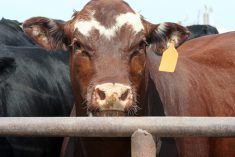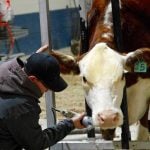Western Canadian feeder cattle markets were quite variable over the past week. Auction barns in Manitoba and Saskatchewan remain in holiday mode. However, markets are coming to life in Alberta. Certain ranchers are starting to sell early bloomers and there’s no shortage of demand for these yearlings.
In east-central Alberta, a couple of small groups of various-quality medium-flesh mixed steers weighing around 825 lbs. were quoted at $200, while 875-lb. mixed steers were trading in the range of $188-$190. In southern Alberta, a small group of medium-frame Angus-based mixed steers averaging 725 lbs. were quoted at $215. The markets were quite firm despite the smaller groups of average quality cattle. There’s a fair amount of optimism given the prolonged period of positive margins this past spring and summer. The weaker fed cattle prices and softer wholesale values this week did little to stem enthusiasm. Alberta packers were buying fed cattle from $139 to $141 and feeding margins are narrowing; however, the cattle being placed in August will only come on the fed market over the winter period. Feedlot operators are gearing up for a similar price pattern as last year, with lower beef production during the first quarter of 2018.
Read Also

Canadian trade data delayed by U.S. government shutdown
Canadian international trade data for September will be delayed indefinitely due to the ongoing partial shutdown of the United States government, Statistics Canada said Friday, Oct. 24.
Heavier calves were also well wanted; mixed Simmental-base steers weighing just under 650 lbs. were quoted at $232 in central Alberta while a small group of mixed medium- to larger-frame heifers averaging 590 lbs. were quoted at $220. Buyers were not afraid to pay up on quality cattle. The grain harvest is underway, which kept many backgrounding operators at bay. At the same time, farmers are not looking to sell their grass cattle until the market is better defined.
In the southern regions of Saskatchewan, pastures have deteriorated but comments from other regions suggest there is no shortage of forage. The central regions of Alberta and central and northern parts of Saskatchewan are in fairly good shape after last week’s rains. We may not see as many yearlings come on the market as anticipated in August. Only a small region of Western Canada has been affected by the drought-like conditions. Buyers will be scrambling to get their hands on these early high-quality yearlings.
— Jerry Klassen manages the Canadian office of Swiss-based grain trader GAP SA Grains and Produits Ltd. and is president and founder of Resilient Capital, specializing in proprietary commodity futures trading and market analysis. Jerry consults with feedlots on risk management and writes a weekly cattle market commentary. He can be reached at 204-504-8339.

















